2004 CHEVROLET ASTRO CARGO VAN automatic transmission
[x] Cancel search: automatic transmissionPage 347 of 386
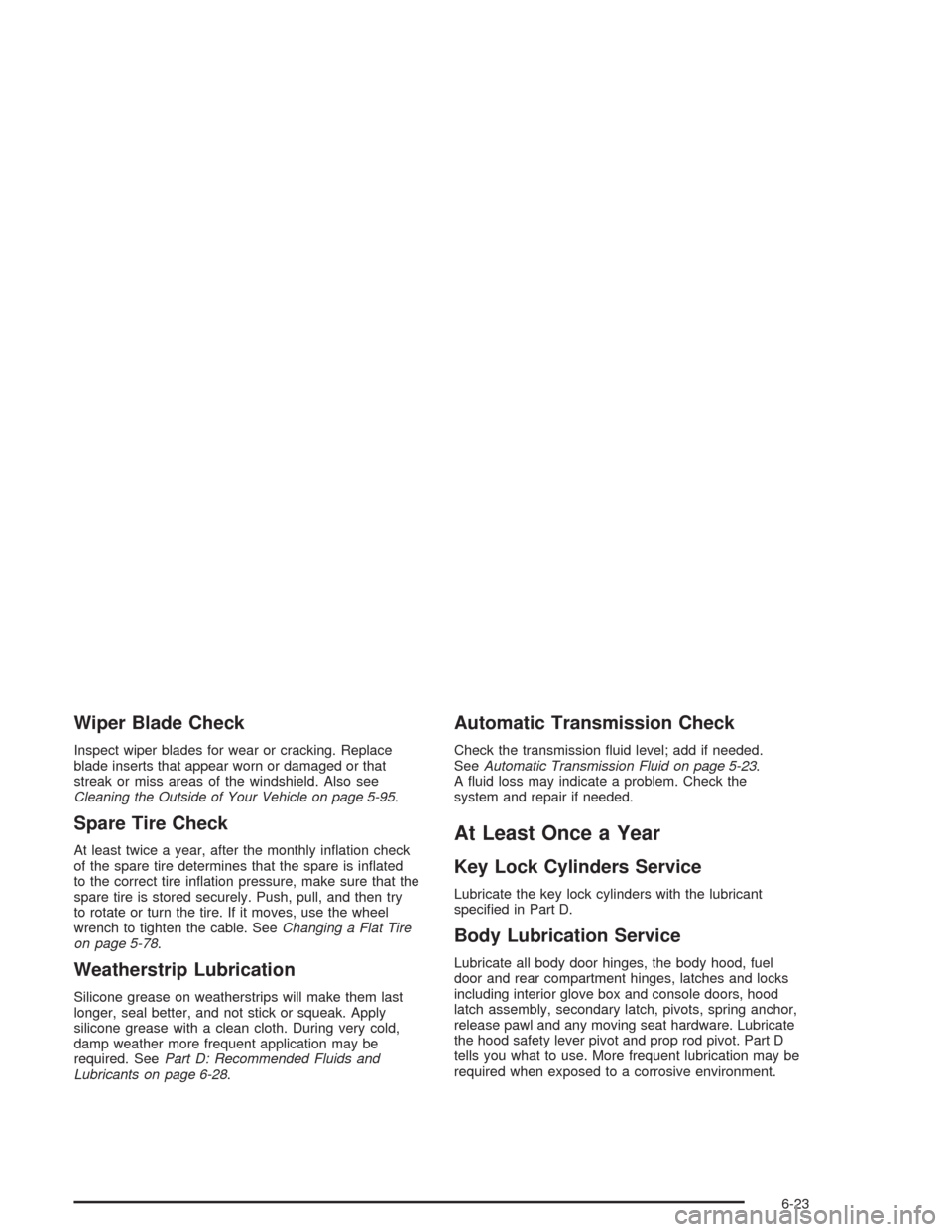
Wiper Blade Check
Inspect wiper blades for wear or cracking. Replace
blade inserts that appear worn or damaged or that
streak or miss areas of the windshield. Also see
Cleaning the Outside of Your Vehicle on page 5-95.
Spare Tire Check
At least twice a year, after the monthly in�ation check
of the spare tire determines that the spare is in�ated
to the correct tire in�ation pressure, make sure that the
spare tire is stored securely. Push, pull, and then try
to rotate or turn the tire. If it moves, use the wheel
wrench to tighten the cable. SeeChanging a Flat Tire
on page 5-78.
Weatherstrip Lubrication
Silicone grease on weatherstrips will make them last
longer, seal better, and not stick or squeak. Apply
silicone grease with a clean cloth. During very cold,
damp weather more frequent application may be
required. SeePart D: Recommended Fluids and
Lubricants on page 6-28.
Automatic Transmission Check
Check the transmission �uid level; add if needed.
SeeAutomatic Transmission Fluid on page 5-23.
A �uid loss may indicate a problem. Check the
system and repair if needed.
At Least Once a Year
Key Lock Cylinders Service
Lubricate the key lock cylinders with the lubricant
speci�ed in Part D.
Body Lubrication Service
Lubricate all body door hinges, the body hood, fuel
door and rear compartment hinges, latches and locks
including interior glove box and console doors, hood
latch assembly, secondary latch, pivots, spring anchor,
release pawl and any moving seat hardware. Lubricate
the hood safety lever pivot and prop rod pivot. Part D
tells you what to use. More frequent lubrication may be
required when exposed to a corrosive environment.
6-23
Page 348 of 386
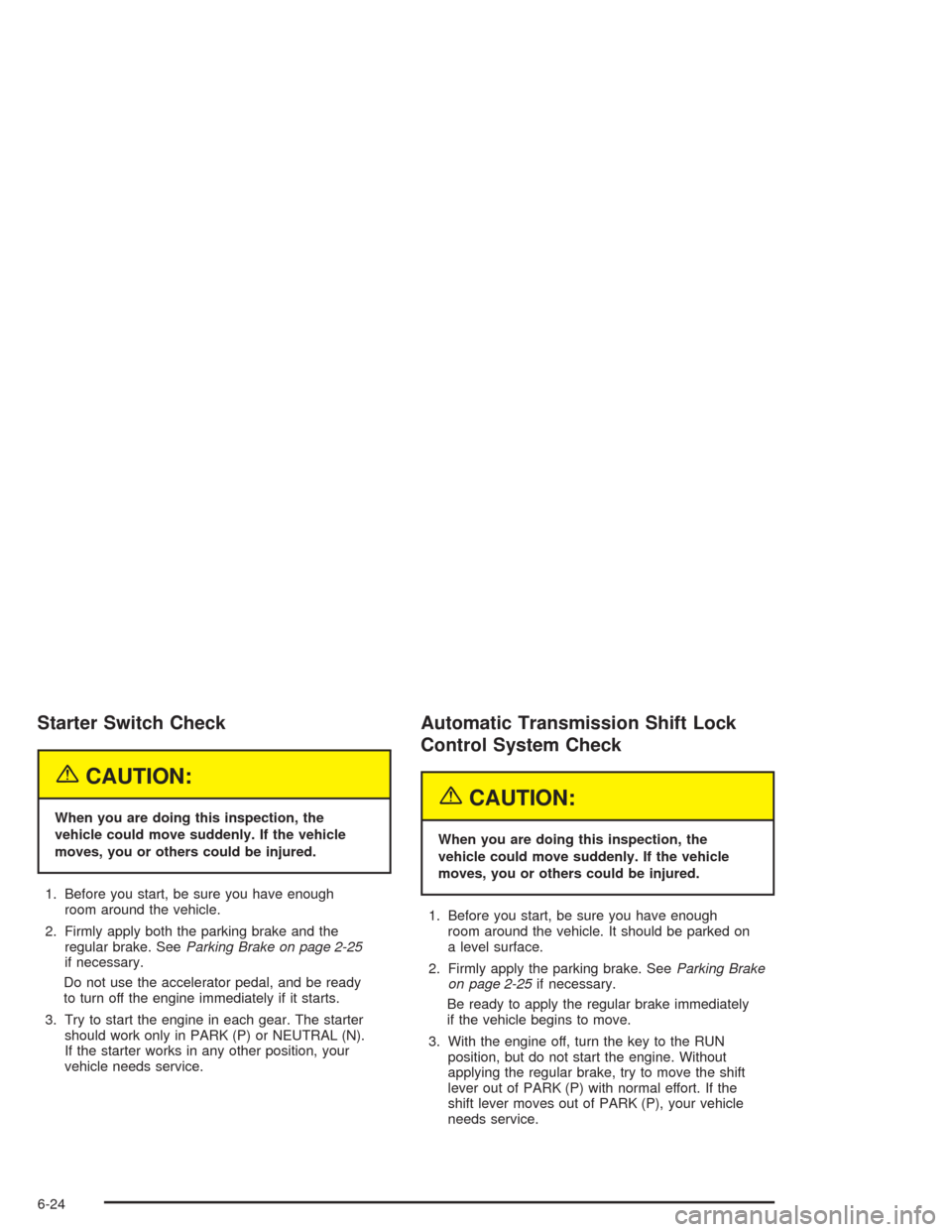
Starter Switch Check
{CAUTION:
When you are doing this inspection, the
vehicle could move suddenly. If the vehicle
moves, you or others could be injured.
1. Before you start, be sure you have enough
room around the vehicle.
2. Firmly apply both the parking brake and the
regular brake. SeeParking Brake on page 2-25
if necessary.
Do not use the accelerator pedal, and be ready
to turn off the engine immediately if it starts.
3. Try to start the engine in each gear. The starter
should work only in PARK (P) or NEUTRAL (N).
If the starter works in any other position, your
vehicle needs service.
Automatic Transmission Shift Lock
Control System Check
{CAUTION:
When you are doing this inspection, the
vehicle could move suddenly. If the vehicle
moves, you or others could be injured.
1. Before you start, be sure you have enough
room around the vehicle. It should be parked on
a level surface.
2. Firmly apply the parking brake. SeeParking Brake
on page 2-25if necessary.
Be ready to apply the regular brake immediately
if the vehicle begins to move.
3. With the engine off, turn the key to the RUN
position, but do not start the engine. Without
applying the regular brake, try to move the shift
lever out of PARK (P) with normal effort. If the
shift lever moves out of PARK (P), your vehicle
needs service.
6-24
Page 349 of 386
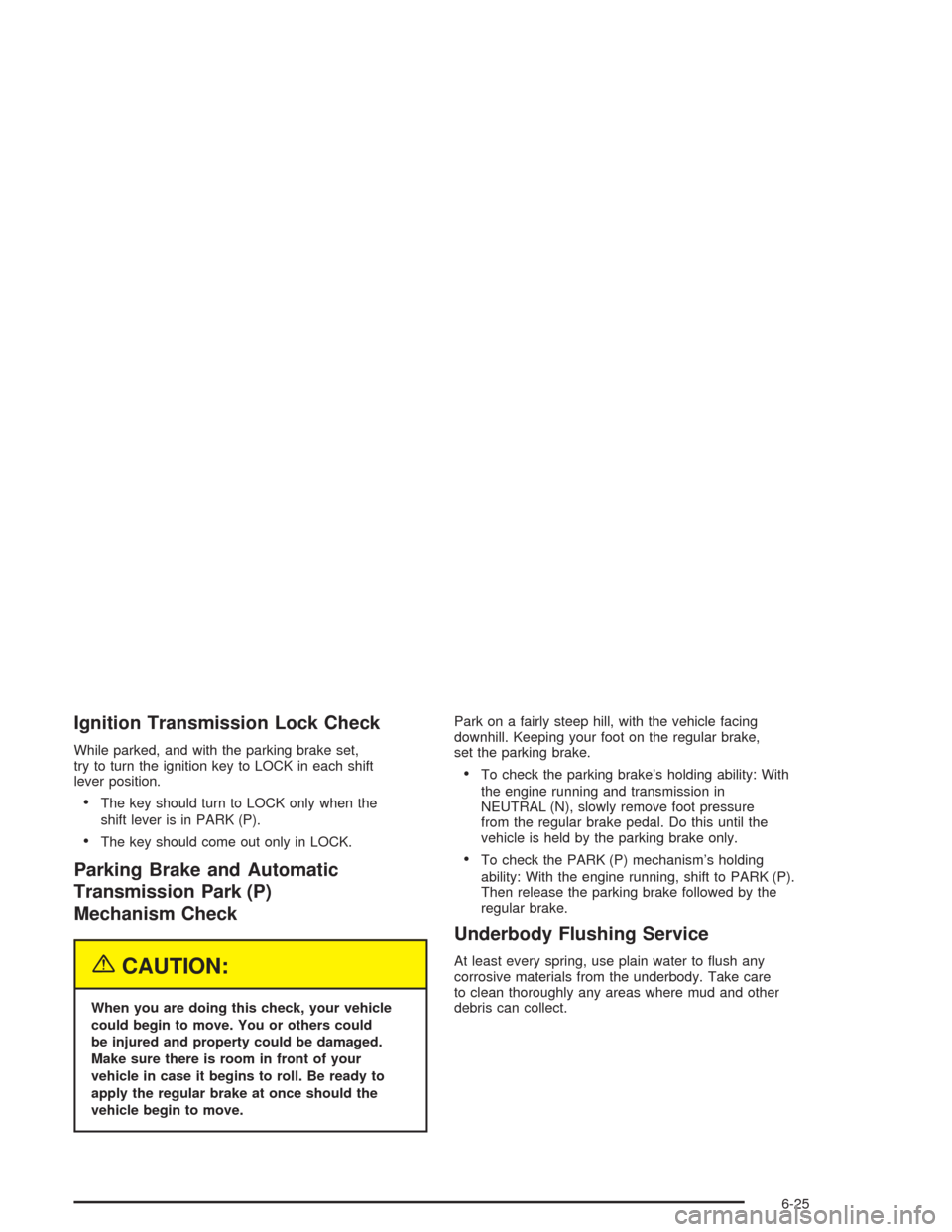
Ignition Transmission Lock Check
While parked, and with the parking brake set,
try to turn the ignition key to LOCK in each shift
lever position.
The key should turn to LOCK only when the
shift lever is in PARK (P).
The key should come out only in LOCK.
Parking Brake and Automatic
Transmission Park (P)
Mechanism Check
{CAUTION:
When you are doing this check, your vehicle
could begin to move. You or others could
be injured and property could be damaged.
Make sure there is room in front of your
vehicle in case it begins to roll. Be ready to
apply the regular brake at once should the
vehicle begin to move.Park on a fairly steep hill, with the vehicle facing
downhill. Keeping your foot on the regular brake,
set the parking brake.
To check the parking brake’s holding ability: With
the engine running and transmission in
NEUTRAL (N), slowly remove foot pressure
from the regular brake pedal. Do this until the
vehicle is held by the parking brake only.
To check the PARK (P) mechanism’s holding
ability: With the engine running, shift to PARK (P).
Then release the parking brake followed by the
regular brake.
Underbody Flushing Service
At least every spring, use plain water to �ush any
corrosive materials from the underbody. Take care
to clean thoroughly any areas where mud and other
debris can collect.
6-25
Page 352 of 386
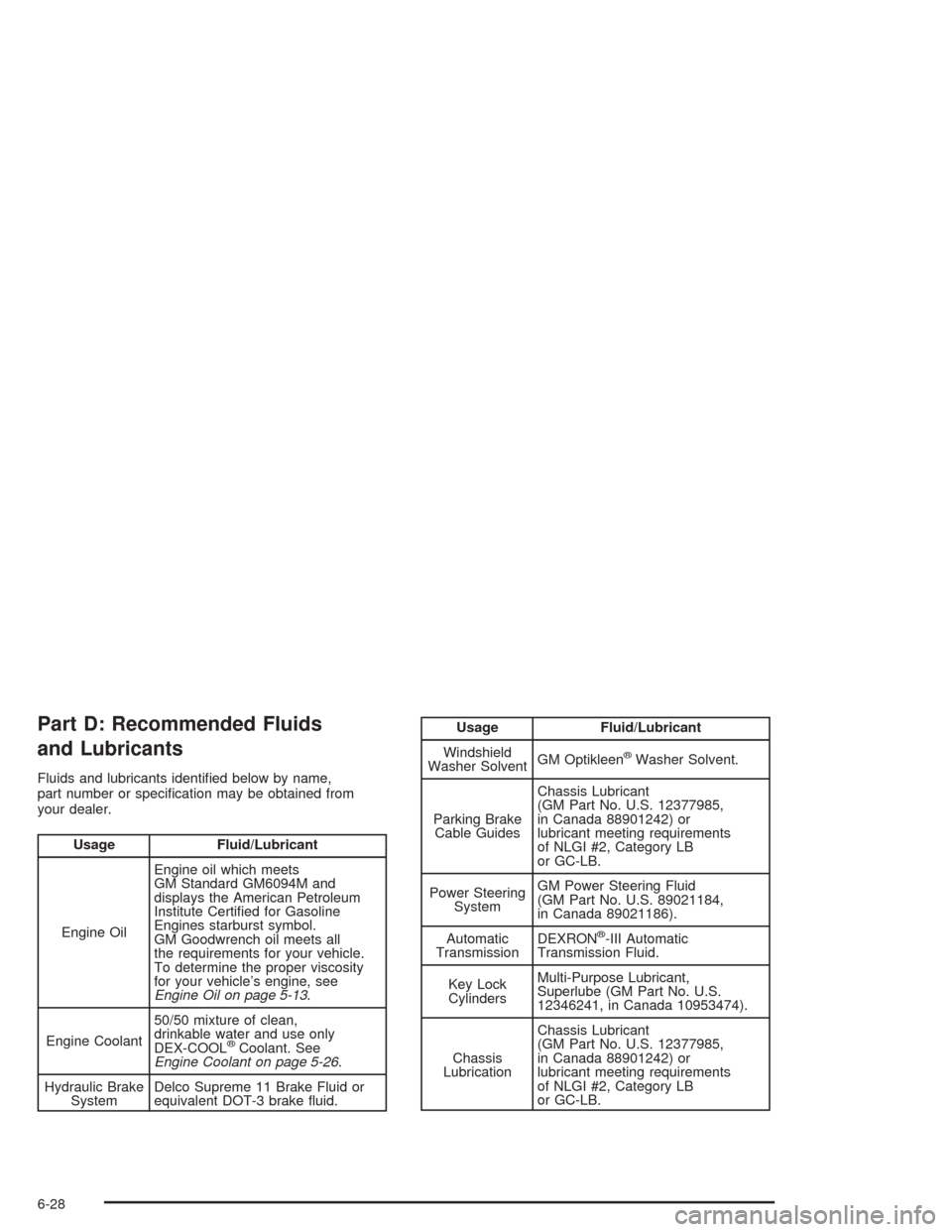
Part D: Recommended Fluids
and Lubricants
Fluids and lubricants identi�ed below by name,
part number or speci�cation may be obtained from
your dealer.
Usage Fluid/Lubricant
Engine OilEngine oil which meets
GM Standard GM6094M and
displays the American Petroleum
Institute Certi�ed for Gasoline
Engines starburst symbol.
GM Goodwrench oil meets all
the requirements for your vehicle.
To determine the proper viscosity
for your vehicle’s engine, see
Engine Oil on page 5-13.
Engine Coolant50/50 mixture of clean,
drinkable water and use only
DEX-COOL
®Coolant. See
Engine Coolant on page 5-26.
Hydraulic Brake
SystemDelco Supreme 11 Brake Fluid or
equivalent DOT-3 brake �uid.
Usage Fluid/Lubricant
Windshield
Washer SolventGM Optikleen
®Washer Solvent.
Parking Brake
Cable GuidesChassis Lubricant
(GM Part No. U.S. 12377985,
in Canada 88901242) or
lubricant meeting requirements
of NLGI #2, Category LB
or GC-LB.
Power Steering
SystemGM Power Steering Fluid
(GM Part No. U.S. 89021184,
in Canada 89021186).
Automatic
TransmissionDEXRON
®-III Automatic
Transmission Fluid.
Key Lock
CylindersMulti-Purpose Lubricant,
Superlube (GM Part No. U.S.
12346241, in Canada 10953474).
Chassis
LubricationChassis Lubricant
(GM Part No. U.S. 12377985,
in Canada 88901242) or
lubricant meeting requirements
of NLGI #2, Category LB
or GC-LB.
6-28
Page 372 of 386
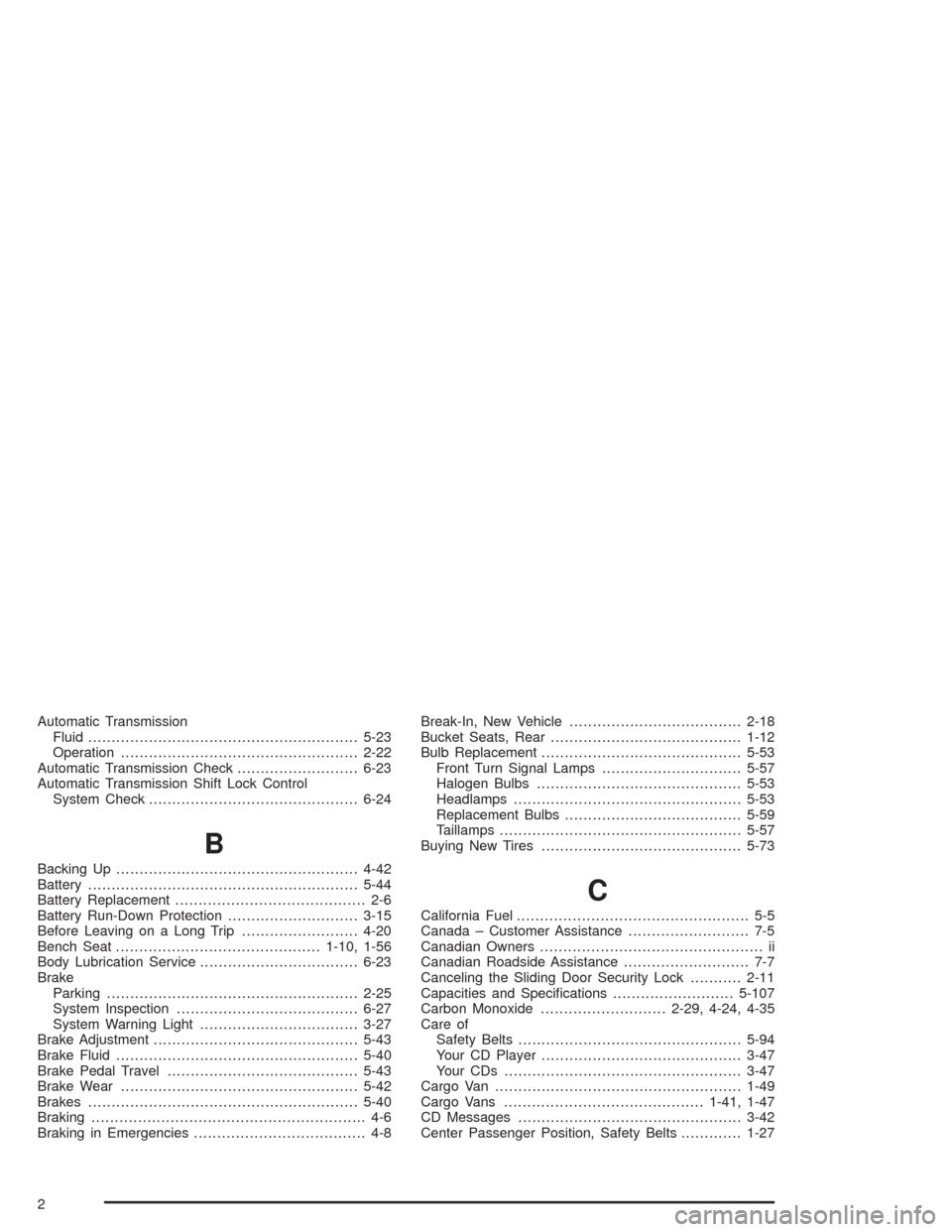
Automatic Transmission
Fluid..........................................................5-23
Operation...................................................2-22
Automatic Transmission Check..........................6-23
Automatic Transmission Shift Lock Control
System Check.............................................6-24
B
Backing Up....................................................4-42
Battery..........................................................5-44
Battery Replacement......................................... 2-6
Battery Run-Down Protection............................3-15
Before Leaving on a Long Trip.........................4-20
Bench Seat............................................1-10, 1-56
Body Lubrication Service..................................6-23
Brake
Parking......................................................2-25
System Inspection.......................................6-27
System Warning Light..................................3-27
Brake Adjustment............................................5-43
Brake Fluid....................................................5-40
Brake Pedal Travel.........................................5-43
Brake Wear...................................................5-42
Brakes..........................................................5-40
Braking........................................................... 4-6
Braking in Emergencies..................................... 4-8Break-In, New Vehicle.....................................2-18
Bucket Seats, Rear.........................................1-12
Bulb Replacement...........................................5-53
Front Turn Signal Lamps..............................5-57
Halogen Bulbs............................................5-53
Headlamps.................................................5-53
Replacement Bulbs......................................5-59
Taillamps....................................................5-57
Buying New Tires...........................................5-73
C
California Fuel.................................................. 5-5
Canada – Customer Assistance.......................... 7-5
Canadian Owners................................................ ii
Canadian Roadside Assistance........................... 7-7
Canceling the Sliding Door Security Lock...........2-11
Capacities and Speci�cations..........................5-107
Carbon Monoxide...........................2-29, 4-24, 4-35
Care of
Safety Belts................................................5-94
Your CD Player...........................................3-47
Your CDs ...................................................3-47
Cargo Van.....................................................1-49
Cargo Vans...........................................1-41, 1-47
CD Messages................................................3-42
Center Passenger Position, Safety Belts.............1-27
2
Page 375 of 386
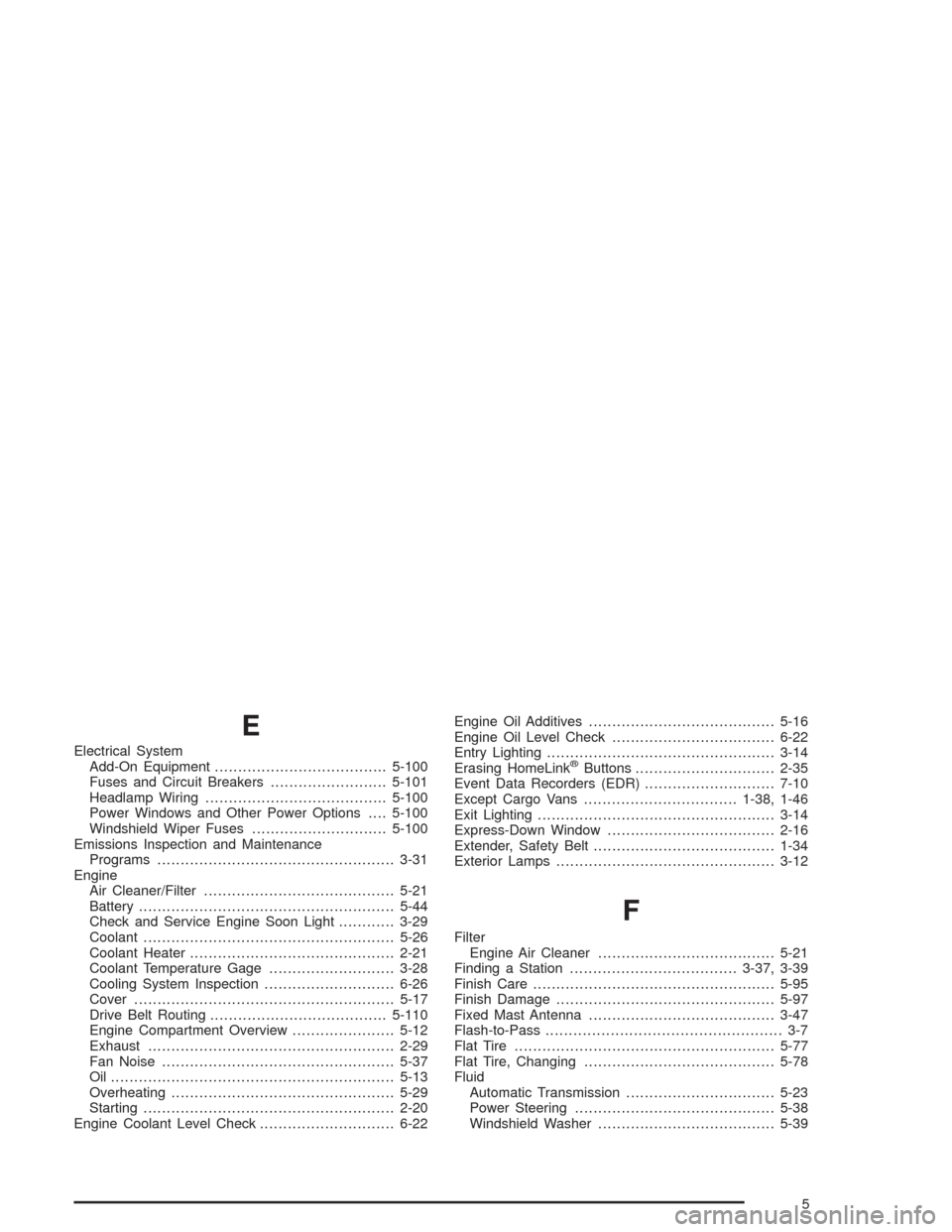
E
Electrical System
Add-On Equipment.....................................5-100
Fuses and Circuit Breakers.........................5-101
Headlamp Wiring.......................................5-100
Power Windows and Other Power Options....5-100
Windshield Wiper Fuses.............................5-100
Emissions Inspection and Maintenance
Programs...................................................3-31
Engine
Air Cleaner/Filter.........................................5-21
Battery.......................................................5-44
Check and Service Engine Soon Light............3-29
Coolant......................................................5-26
Coolant Heater............................................2-21
Coolant Temperature Gage...........................3-28
Cooling System Inspection............................6-26
Cover........................................................5-17
Drive Belt Routing......................................5-110
Engine Compartment Overview......................5-12
Exhaust.....................................................2-29
Fan Noise..................................................5-37
Oil .............................................................5-13
Overheating................................................5-29
Starting......................................................2-20
Engine Coolant Level Check.............................6-22Engine Oil Additives........................................5-16
Engine Oil Level Check...................................6-22
Entry Lighting.................................................3-14
Erasing HomeLink®Buttons..............................2-35
Event Data Recorders (EDR)............................7-10
Except Cargo Vans.................................1-38, 1-46
Exit Lighting...................................................3-14
Express-Down Window....................................2-16
Extender, Safety Belt.......................................1-34
Exterior Lamps...............................................3-12
F
Filter
Engine Air Cleaner......................................5-21
Finding a Station....................................3-37, 3-39
Finish Care....................................................5-95
Finish Damage...............................................5-97
Fixed Mast Antenna........................................3-47
Flash-to-Pass................................................... 3-7
Flat Tire........................................................5-77
Flat Tire, Changing.........................................5-78
Fluid
Automatic Transmission................................5-23
Power Steering...........................................5-38
Windshield Washer......................................5-39
5
Page 380 of 386
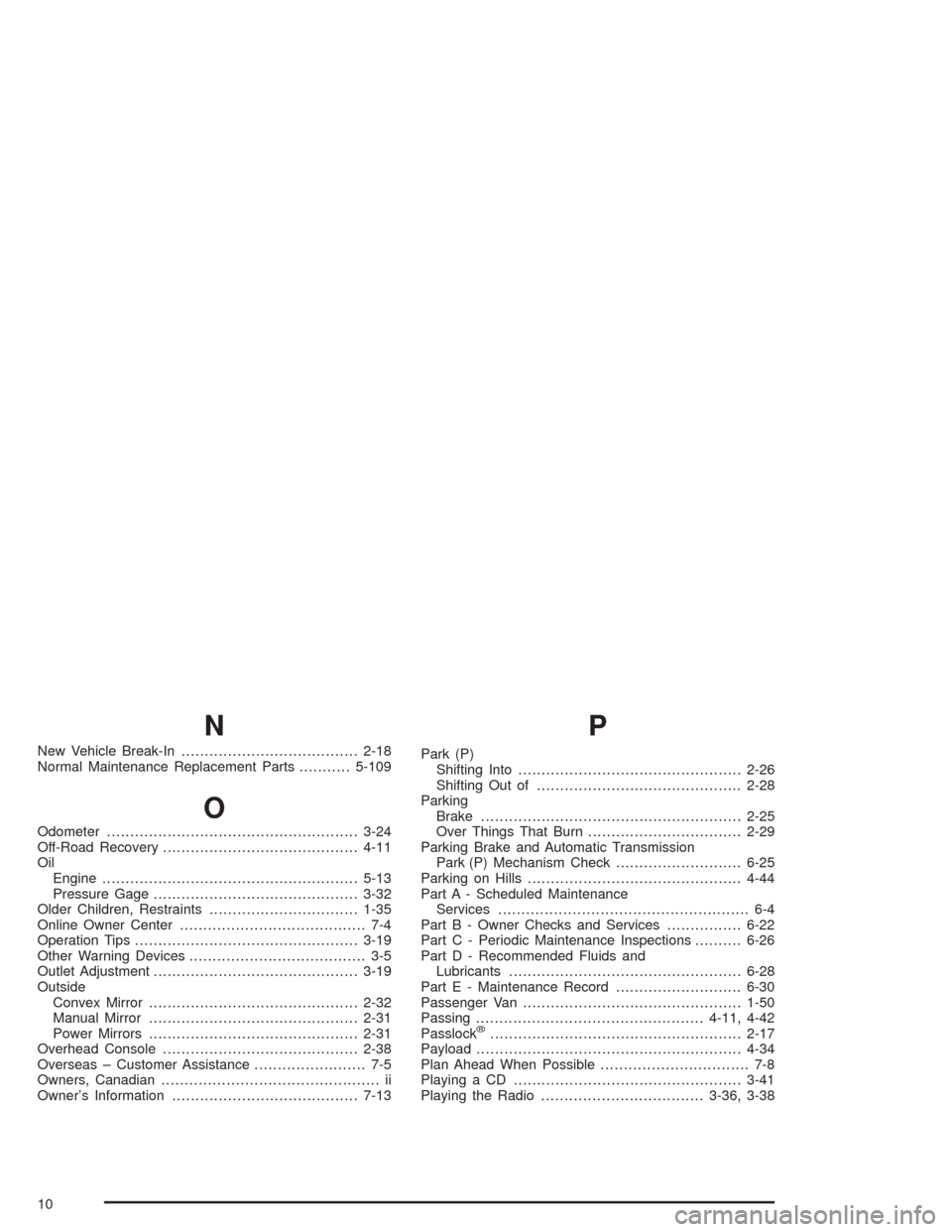
N
New Vehicle Break-In......................................2-18
Normal Maintenance Replacement Parts...........5-109
O
Odometer......................................................3-24
Off-Road Recovery..........................................4-11
Oil
Engine.......................................................5-13
Pressure Gage............................................3-32
Older Children, Restraints................................1-35
Online Owner Center........................................ 7-4
Operation Tips................................................3-19
Other Warning Devices...................................... 3-5
Outlet Adjustment............................................3-19
Outside
Convex Mirror.............................................2-32
Manual Mirror.............................................2-31
Power Mirrors.............................................2-31
Overhead Console..........................................2-38
Overseas – Customer Assistance........................ 7-5
Owners, Canadian............................................... ii
Owner’s Information........................................7-13
P
Park (P)
Shifting Into................................................2-26
Shifting Out of............................................2-28
Parking
Brake........................................................2-25
Over Things That Burn.................................2-29
Parking Brake and Automatic Transmission
Park (P) Mechanism Check...........................6-25
Parking on Hills..............................................4-44
Part A - Scheduled Maintenance
Services...................................................... 6-4
Part B - Owner Checks and Services................6-22
Part C - Periodic Maintenance Inspections..........6-26
Part D - Recommended Fluids and
Lubricants..................................................6-28
Part E - Maintenance Record...........................6-30
Passenger Van...............................................1-50
Passing.................................................4-11, 4-42
Passlock
®......................................................2-17
Payload.........................................................4-34
Plan Ahead When Possible................................ 7-8
Playing a CD.................................................3-41
Playing the Radio...................................3-36, 3-38
10
Page 384 of 386
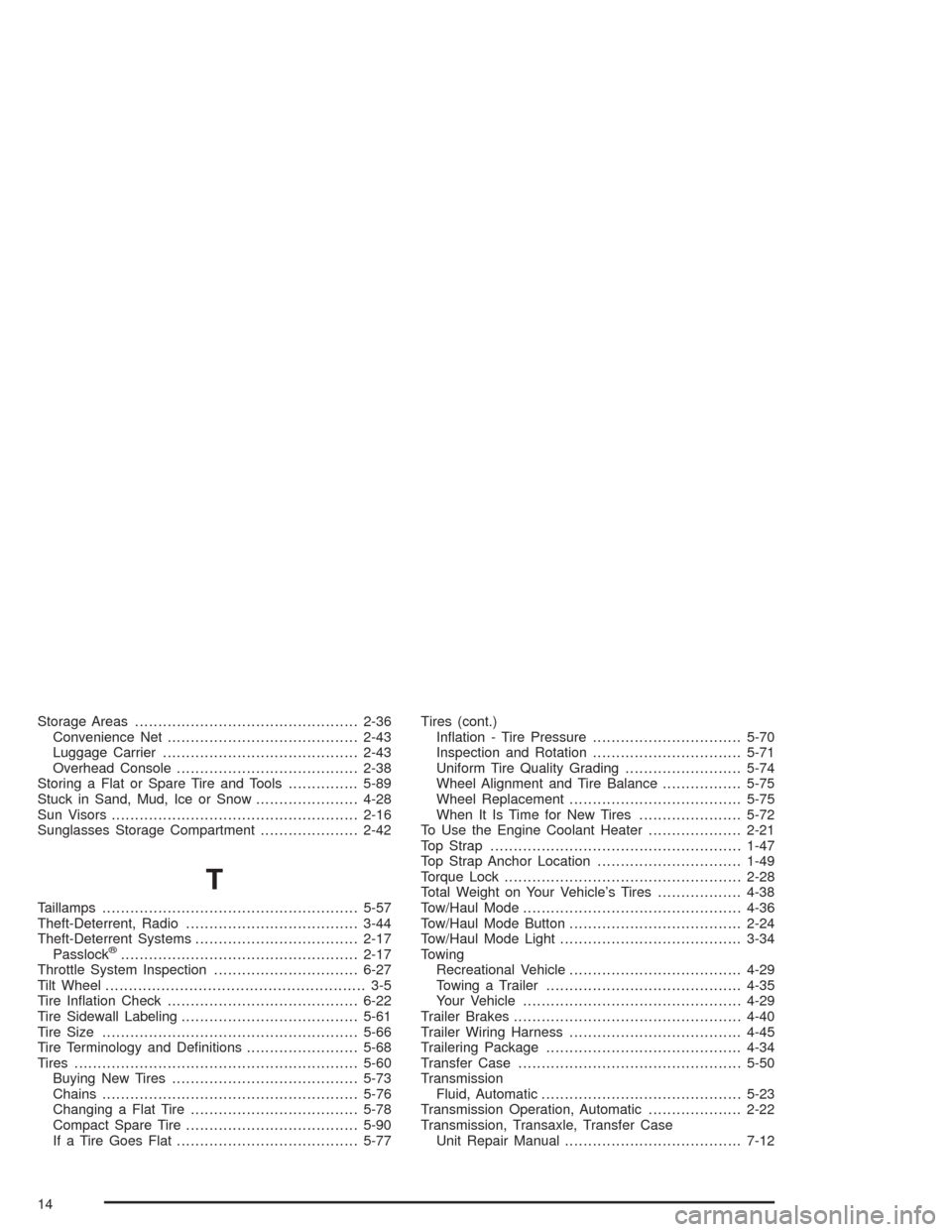
Storage Areas................................................2-36
Convenience Net.........................................2-43
Luggage Carrier..........................................2-43
Overhead Console.......................................2-38
Storing a Flat or Spare Tire and Tools...............5-89
Stuck in Sand, Mud, Ice or Snow......................4-28
Sun Visors.....................................................2-16
Sunglasses Storage Compartment.....................2-42
T
Taillamps.......................................................5-57
Theft-Deterrent, Radio.....................................3-44
Theft-Deterrent Systems...................................2-17
Passlock
®...................................................2-17
Throttle System Inspection...............................6-27
Tilt Wheel........................................................ 3-5
Tire In�ation Check.........................................6-22
Tire Sidewall Labeling......................................5-61
Tire Size.......................................................5-66
Tire Terminology and De�nitions........................5-68
Tires.............................................................5-60
Buying New Tires........................................5-73
Chains.......................................................5-76
Changing a Flat Tire....................................5-78
Compact Spare Tire.....................................5-90
If a Tire Goes Flat.......................................5-77Tires (cont.)
In�ation - Tire Pressure................................5-70
Inspection and Rotation................................5-71
Uniform Tire Quality Grading.........................5-74
Wheel Alignment and Tire Balance.................5-75
Wheel Replacement.....................................5-75
When It Is Time for New Tires......................5-72
To Use the Engine Coolant Heater....................2-21
Top Strap......................................................1-47
Top Strap Anchor Location...............................1-49
Torque Lock...................................................2-28
Total Weight on Your Vehicle’s Tires..................4-38
Tow/Haul Mode...............................................4-36
Tow/Haul Mode Button.....................................2-24
Tow/Haul Mode Light.......................................3-34
Towing
Recreational Vehicle.....................................4-29
Towing a Trailer..........................................4-35
Your Vehicle...............................................4-29
Trailer Brakes.................................................4-40
Trailer Wiring Harness.....................................4-45
Trailering Package..........................................4-34
Transfer Case................................................5-50
Transmission
Fluid, Automatic...........................................5-23
Transmission Operation, Automatic....................2-22
Transmission, Transaxle, Transfer Case
Unit Repair Manual......................................7-12
14